What is the transistor and its act?
What is the transistor and its act?
The transistor is a solid semiconductor device with various functions of wave detection, rectification, amplification, switching, voltage stabilization, and signal modulation. The transistor is capable of controlling the output current based on the input voltage. Different from ordinary mechanical switches, transistors use electrical signals to control their own opening and closing, and the switching speed can be very fast, and the switching speed in the laboratory can reach more than 100GHz.
Transistor act on:
1. Diodes can be used as one-way switches
2. The triode can be amplified by an overcurrent
3. Logical operation can also be performed through the splicing of triodes
4. The chips used are all digital or analog circuits formed by the splicing of transistors
The working principle of the transistor is simple, the current flowing between the base PS2707-1 and the emitter is continuously monitored, and the current source between the collector and the current (depending on the type of transistors) the current flows between the collector and the emitter. That is, a transistor is a device that uses the base current to control the transmitter current of the collector.
Externally, because the current input at the base is enlarged and appears at the collector and emission extremes, it can be regarded as the input signal is amplified. Although there are thousands of varieties of actual transistors, they only differ in terms of large specifications, electrical characteristics and shapes.
A transistor is a device that detects the current flowing between the base and the emitter, and then controls the current between the collector, so as long as the current flows between the base and the emitter, it works. In other words, design an external circuit so that the current between the base can flow.
The transistor is a simple component that can be used to construct many interesting circuits. In this article, it will take you to understand how transistors work so that you can use them in the later circuit design.
Once you know the basics of transistors, this is actually quite easy. We will focus on the two most common transistors: BJT and MOSFET.
The transistor works like an electronic switch, which turns on and off the current. A simple way to think is to see a transistor as a switch without any action parts, and a transistor is similar to a relay because you can use it to turn something on or off. Of course, the transistor can also be partially opened, which is useful for the amplifier design.
1.Operating principle of the transistor BJT
Let's start with the classic NPN transistors.
The following figure is a bipolar junction transistor (BJT) with three pins:
B (B)
collector (C)
emitter (E)

If you turn it on, the current can pass through it from the collector to the emitter. When it is closed, no electric current flows through it.
In the following example circuit, the transistor is closed. This means that no electric current can pass through it, and so the LEDs are also turned off.

To open the transistor, the voltage between the base pole and the emitter is about 0.7V.
If you have a 0.7V battery, you can connect it between the base pole and the emitter, and the transistor will turn on.
Since most of us don't have a 0.7V battery, how do we turn on the transistors?
as easy as pie! The base-to-emitter part of the transistor works as a diode, which has a forward voltage that "grabs" the voltage from the available voltage. If you add a resistor in the series, the rest of the voltage will be split on the resistor.
So, add a resistor and you automatically get about 0.7V. It's the same principle as if you limit the current through the LED to make sure it doesn't explode.
If a key switch is added, the transistor and the LED:
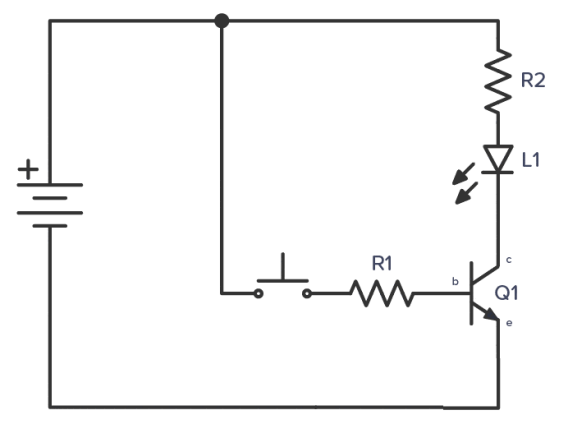
1.1 Select the value of the components
To choose the value of the component, you also need to know how the transistors work: when the current flows from the base to the emitter, the transistor opens so that a larger current can flow from the collector to the emitter.

The magnitude of these two currents is related, which is called the transistors' gain.
For general-purpose transistors, such as BC547 or 2N3904, this may be around 100.
This means that if you have 0.1 mA from the base to the emitter, you can have 10 mAh (100 times more) from the collector to the emitter.
What resistance R1 to get a current of 0.1 mA?
If the battery is 9V and the transistor base to emitter reaches 0.7V, then there is still 8.3V on the resistor.
You can use Ohm's law to find the resistance value:

So you need an 83 kΩ resistance. Not necessarily for this standard value, 82 kΩ works, and it's enough.
R2 can limit the current to the LED and can select the resistance value used to connect the LED and the resistance directly to the 9V battery without a transistor. For example, 1 kΩ should be enough to work normally.
1.2 How to select the transistor
The NPN transistor is the most common bipolar junction transistor (BJT). But there is also a PNP transistor that works the same way as it does, but all the current is in the opposite direction.
When selecting a transistor, it is most important to remember how much current the transistor can withstand. This is called the collector current (iC).
2 MOSFET works
MOSFET The transistor is another common transistor.
It also has three other pins:
GateG)
Source(S)
Drain(D)
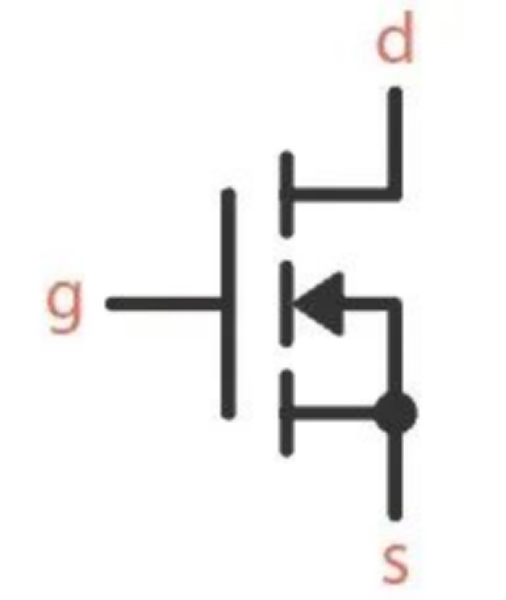
MOSFET Sign (N channel)
MOS works in a similar way to BJT transistors, but with one important difference:
For the BJT transistor, the current goes from one base to another emitter, determining how much current can flow from the collector to the emitter.
For the MOSFET transistor, the current between the voltage gate and the source determines how much current can flow from the drain to another source.
2.1 How to open the MOSFET
Below is an example of a circuit opening on the MOSFET.
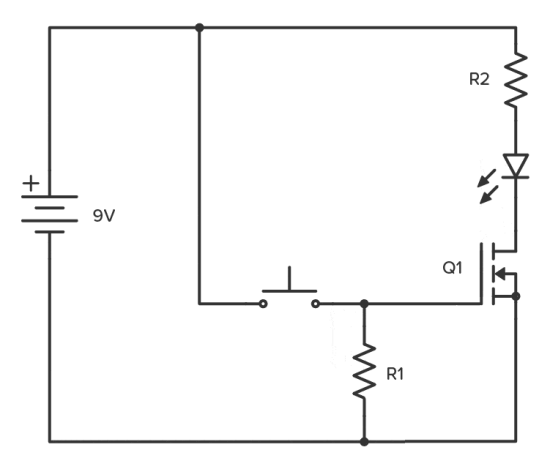
If the MOSFET transistor is to be opened, the voltage between the gate and the source is higher than the threshold voltage of the transistor. For example, BS170 has a gate source threshold voltage of 2.1V.(Note in Datasheet)
The threshold voltage of MOSFET is actually the voltage that it turns off. Therefore, to open the transistors correctly, you need a slightly higher voltage.
How high the voltage depends on how much current you want to pass through (noted in datasheet). If you are a few volts above the threshold, that is usually enough for low-current things, like turning on an LED.
Please note that even if you use a voltage high enough to get the 1A current through, that doesn't mean you will get the 1A. It just means that you want 1A to pass, and the actual circuit connection properties determine the actual current.
Therefore, you can go to the current you want, as long as you make sure that you do not exceed the maximum gate source voltage limit (the BS170 is 20V).
In the example above, when you press the button, the door is connected to the 9V, which opens up the transistor.
2.2 Select the value of the components
The value of R1 is not important, but about 10 kΩ should work properly and it is intended to close MOSFET. The R2 is used to set the brightness of the LED. For most LEDs, the 1 kΩ should work very well.
Q1 can be almost any N channel MOSFET, for example, BS170.
2.3 How to close the MOSFET
An important feature about MOSFET is that it also works a bit like a capacitor. The gate and the source part, and when you apply a voltage between the gate and the source, this voltage stays until it discharges.
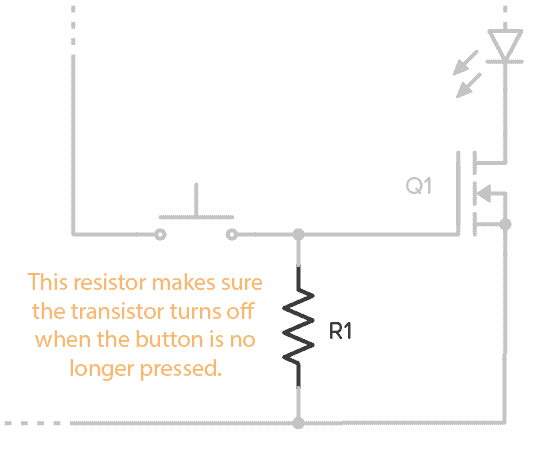
Without the resistor (R1) in the example above, the transistor will not close. With the resistance R1, the gate source capacitance has a closed loop to discharge, thus closing the transistor again.
2.4 How to select the MOSFET transistors
The above example uses N channel MOSFET and P channel MOSFET to work in the same way, except that the current flows in the opposite direction, and the gate to supply voltage must be negative to turn it on.
There are thousands of different MOSFET options available. But if you want to build the above example circuit and want a specific suggestion, BS 170 and IRF 510 are two very commonly used.
Two things to keep in mind when choosing a MOSFET:
This gate-source threshold voltage. You need a higher voltage to turn the transistors on.
This continuous leakage current. This is the maximum electric current flowing through the transistor.
There are other important parameters to remember, though it depends on what you're doing. But that is not within the scope of this article. Remember these two parameters and you get off to a good start.
2.5 MOSFET gate current
If you want to control a MOSFET, for example, a microcontroller, Arduino or Raspberry PI, another thing you need to remember: the current flowing into the gate when you open the transistors.
As mentioned above, the gate-to-source of MOSFET acts as a capacitor, meaning that no more current flows through once charged. Thus, when the MOSFET is turned on, no current flows through the gate.
But when the MOSFET is just turned on there is a current like you do when you charge a capacitor. In very short times, there may be a large current flow.
In order to protect the SU from multiple current, a MOSFET gate resistance:
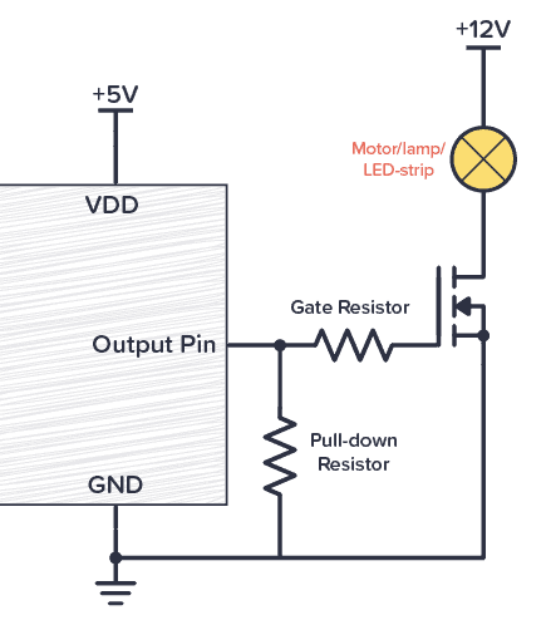
For this, the 1000 Ω is usually a good value. Use Ohm's law to combine your specific case.
3 Why the transistors are needed
A common question is, why do we need transistors? Why not connect the LED and the resistors directly to the battery?
The advantage of a transistor is that you can control a greater current and voltage with a smaller current or voltage.
This is super useful if you want to control things like motors, high power LED, speakers, relays, and more from a Raspberry PI / Arduino / microcontroller. The output pins from these cards are typically provided only a few millips at 5V. Therefore, if you want to control your 110 V outdoor exposed lamp, you can't power directly from the pin.
Instead, you can pass the relay. But, even relays usually require more current than the pin can provide. So you need a transistor to control the relay:

Connect the left side of the resistor to the output pin (starting with the Arduino) to control the relay.
But transistors are also useful for simpler sensor circuits, such as this light-sensor circuit, the touch-sensor circuit, or the H-bridge circuit.
We use transistors in almost all of the circuits. It is indeed the most important component in electronics.
4 The transistor acts as an amplifier
Transistor is also what makes the amplifier work. It is not just two states (on / off), it can also be anywhere between "fully open" and "fully off".
This means that a small signal with little energy can control the transistor, generating a stronger signal in the collector emitter (or leakage source) part of the transistor. Therefore, the transistor can place the size signal.
Below is a simple amplifier used to drive the speaker. The higher the input voltage, the higher the current passing from the base to the emitter, and the higher the current passing through the speaker.
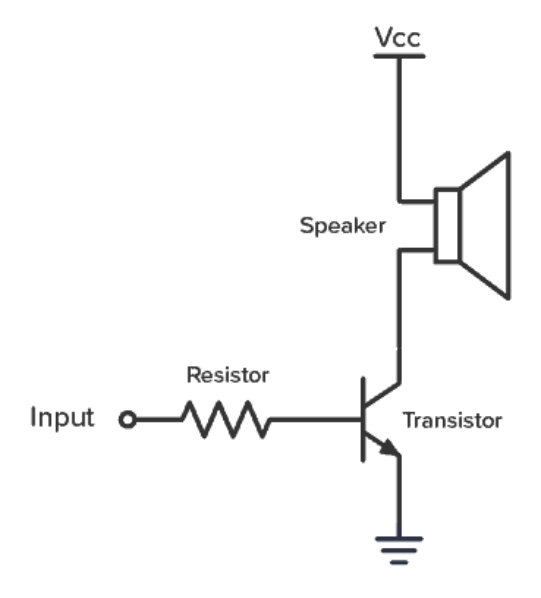
Different input voltages change the current in the speaker.